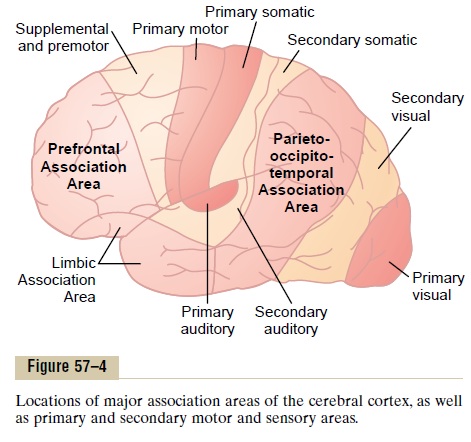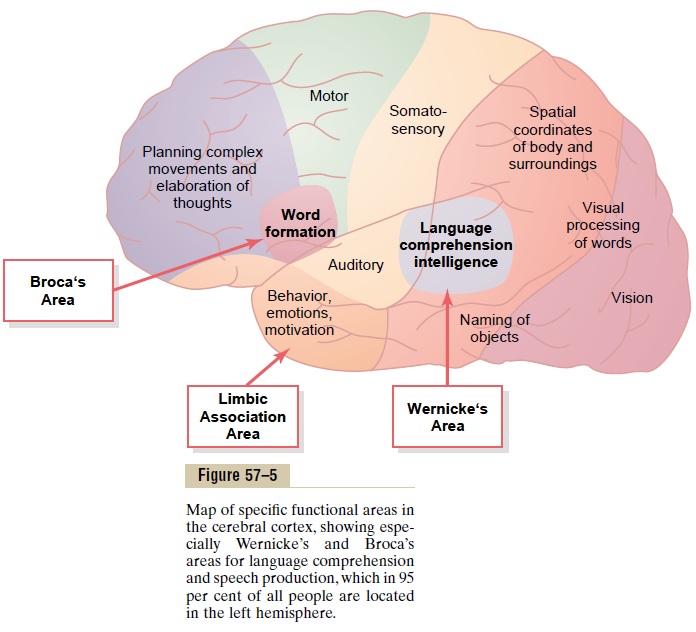Chapter: Medical Physiology: Cerebral Cortex, Intellectual Functions of the Brain, Learning and Memory
Higher Intellectual Functions of the Prefrontal Association Areas
Higher Intellectual Functions of the Prefrontal Association Areas
For years, it has been taught that the prefrontal cortex is the locus of “higher intellect” in the human being, principally because the main difference between the brains of monkeys and of human beings is the great prominence of the human prefrontal areas. Yet, efforts to show that the prefrontal cortex is more important in higher intellectual functions than other portions of the brain have not been successful. Indeed, destruction of the language comprehension area in the posterior superior temporal lobe (Wernicke’s area) and the adjacent angular gyrus region in the dominant hemi-sphere causes much more harm to the intellect than does destruction of the prefrontal areas.The prefrontal areas do, however, have less definable but nevertheless important intellectual functions of their own. These functions can best be explained by describing what happens to patients in whom the prefrontal areas have become nonfunctional, as follows.
Several decades ago, before the advent of modern drugs for treating psychiatric conditions, it was found that some patients could receive significant relief from severe psychotic depression by severing the neuronal connections between the prefrontal areas of the brain and the remainder of the brain, that is, by a procedure called prefrontal lobotomy. This was done by inserting a blunt, thin-bladed knife through a small opening in the lateral frontal skull on each side of the head and slicing the brain at the back edge of the prefrontal lobes from top to bottom. Subsequent studies in these patients showed the following mental changes:
1.The patients lost their ability to solve complex problems.
2.They became unable to string together sequential tasks to reach complex goals.
3.They became unable to learn to do several parallel tasks at the same time.
4.Their level of aggressiveness was decreased, sometimes markedly, and, in general, they lost ambition.
5.Their social responses were often inappropriate for the occasion, often including loss of morals and little reticence in relation to sex and excretion.
6.The patients could still talk and comprehend language, but they were unable to carry through any long trains of thought, and their moods changed rapidly from sweetness to rage to exhilaration to madness.
7.The patients could also still perform most of the usual patterns of motor function that they had performed throughout life, but often without purpose.
From this information, let us try to piece together a coherent understanding of the function of the pre-frontal association areas.
Decreased Aggressiveness and Inappropriate Social Responses. These two characteristics probably resultfrom loss of the ventral parts of the frontal lobes on the underside of the brain. As explained earlier and shown in Figures 57–4 and 57–5, this area is part of the limbic association cortex, rather than of the prefrontal association cortex.

Inability to Progress Toward Goals or to Carry Through Sequen-tial Thoughts. We learned earlier that the prefrontal association areas have the capability of calling forth information from widespread areas of the brain and using this information to achieve deeper thought patterns for attaining goals. If these goals include motor action, so be it. If they do not, then the thought processes attain intellectual analytical goals.
Although people without prefrontal cortices can still think, they show little concerted thinking in logical sequence for longer than a few seconds or a minute or so at most. One of the results is that people without prefrontal cortices are easily distracted from theircentral theme of thought, whereas people with func-tioning prefrontal cortices can drive themselves to completion of their thought goals irrespective of distractions.

Elaboration of Thought, Prognostication, and Performance of Higher Intellectual Functions by the Prefrontal Areas—Concept of a “Working Memory.” Another function that has beenascribed to the prefrontal areas by psychologists and neurologists is elaboration of thought. This means simply an increase in depth and abstractness of the dif-ferent thoughts put together from multiple sources of information. Psychological tests have shown that pre-frontal lobectomized lower animals presented with successive bits of sensory information fail to keep track of these bits even in temporary memory, proba-bly because they are distracted so easily that they cannot hold thoughts long enough for memory storage to take place.
This ability of the prefrontal areas to keep track of many bits of information simultaneously and to cause recall of this information instantaneously as it is needed for subsequent thoughts is called the brain’s “working memory.” This could well explain the many functions of the brain that we associate with higher intelligence. In fact, studies have shown that the pre-frontal areas are divided into separate segments for storing different types of temporary memory, such as one area for storing shape and form of an object or a part of the body and another for storing movement.
By combining all these temporary bits of working memory, we have the abilities to (1) prognosticate; (2) plan for the future; (3) delay action in response to incoming sensory signals so that the sensory informa-tion can be weighed until the best course of response is decided; (4) consider the consequences of motor actions before they are performed; (5) solve compli-cated mathematical, legal, or philosophical problems; (6) correlate all avenues of information in diagnosing rare diseases; and (7) control our activities in accord with moral laws.
Related Topics